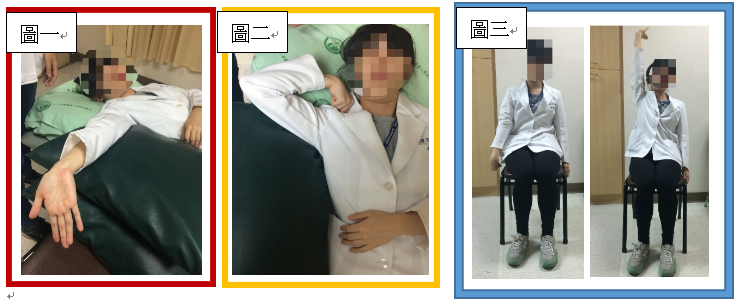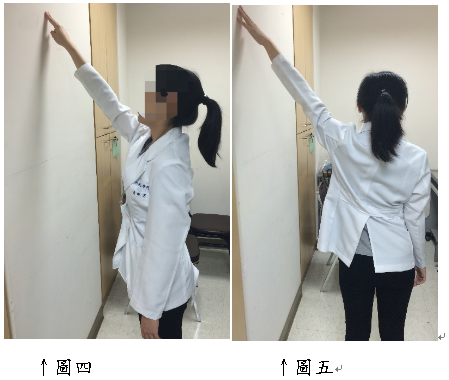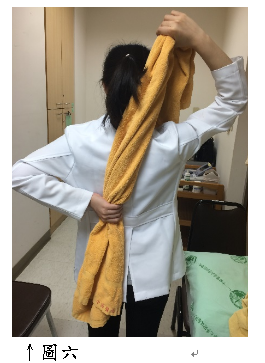Possible problems after surgery
Problems that may occur after surgery include lymphedema on the upper limb of the affected side, tightness in the chest wall or underarm on the surgical side, limited shoulder mobility or pain, upper limb weakness on the affected side, and cardiorespiratory dysfunction. Early intervention and counseling, as well as appropriate rehabilitation programs, can help maintain your quality of life and prevent complications.
Physical therapy and exercise after surgery
- Exercises for edema:
- Movement 1: Lie down, open your arm 45-90 degrees and put two pillows under it at a level higher than the heart. Stretch the wrist and straighten the elbow for about 5 seconds (Figure 1). Next, bend your wrist and arm to touch your shoulder for about 5 seconds (Figure 2). It is advised to move back and forth for 10 times in a row, three cycles a day.
- Movement 2: Sit or stand with your hands above your head, and move and exercise with a frequency as suggested above. (Figure 3)

Figure 1 Figure 2 Figure 3
- Prevent the scar adhesion to the surgical wound:
- After the initial healing of scars (about 3 weeks later), press on scars and nearby tissues can help the tissues soften, reduce adhesions and smooth the scars.
- Scar massage: gently press on the scar, give stable pressure and move slowly parallel to the wound, from the opening to the end of the scar. After the pain at the wound is reduced, apply deep pressure perpendicular to the scar by moving up and down. It is advised to go back and forth 3-5 times. Muscles near the wound can also be pressed.
- Prevent the decreased range of motion of the shoulder joint or pain:
After surgery, patients do not do exercise properly for fear of wound pain or skin tears. However, holding your body in the same position for long periods of time is likely to result in muscle stiffness, decreased blood circulation and decreased mobility, and then joint symptoms and pain such as frozen shoulder over time. Therefore, appropriate and gradual movement is needed to prevent future problems
- Finger ladder exercise (abduction, flexion):
- Movement 1: Keep your body straight and do not stay hunched over, face the wall and stick your palms against the wall (Figure 4 arm flexion). Move your hands up the wall with your fingers, and stop for about 15 seconds at a height when you feel tight but not painful. Then slide your hands down the wall until your hands are away from the wall. It is advised to go back and forth 10 times, 3 cycles a day.
- Movement 2: Keep your body straight and do not stay hunched over. Press the arm on the affected side against the wall (Figure 5 arm abduction). The rest is the same as Movement 1.

Figure 4 Figure 5
- Towel exercise (external rotation/internal rotation):
- Movement 1: Sit with your body straight and not hunched over; with the hand on the affected side on the top while placing the other side near the lower back. Pull a towel on the back, with the hand on the healthy side reaching down as far as possible (the hand on the affected side turns outwards), and stop at a position where you feel tight but not painful for 15 seconds. It is advised to go back and forth 10 times, 3 cycles a day.
- Movement 2: Sit with your body straight and not hunched over; with the hand on the unaffected side on the top while placing the other side near the lower back. Pull a towel on the back, with the hand on the healthy side reaching up as far as possible (the hand on the affected side turns inwards), and stop at a position where you feel tight but not painful for 15 seconds. It is advised to go back and forth 10 times, 3 cycles a day (Figure 6).

Figure 6
- Prevent tight chest muscles and avoid adhesion to the chest:
- Chest expansion with breathing:
- Movement 1: Sit with your back pressed into the chair and your chest sticking out (not hunched). Put your hands on the back of your head, open your elbows outwards, and stop at a position where you feel tight but not painful for 15 seconds. It is advised to go back and forth 10 times, 3 cycles a day (Figure 7).
- Movement 2: Stand upright (not hunched). Keep your head forward, with your hands extending back and down and stop at a position where you feel tight but not painful for 15 seconds. It is advised to go back and forth 10 times, 3 cycles a day (Figure 8).

Figure 7 Figure 8
Notes for daily life after surgery
- Avoid injections, measuring blood pressure, wearing too tight jewelry or clothing for your affected side.
- Your affected side should avoid contact with excessive heat sources (e.g. hot spring, sauna, etc.), picking up heavy items, swinging, which is prone to lymphedema.
- Avoid any wounds such as scalds, stabs, mosquito bites, dry cracks), and treat them immediately to prevent infection.
- If the arm has lymphedema for more than 3 days, pain, or a decreased range of motion after more than one month, please consult the rehabilitation department.
- Exercise should not be excessive, and should be carried out in the right posture; the dose varies from person to person, and it can be done according to one’s physical strength.

